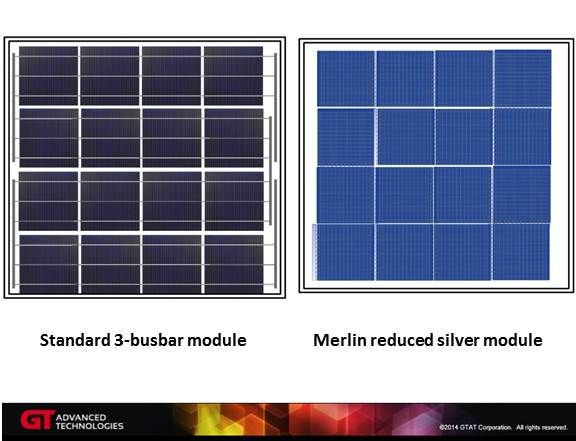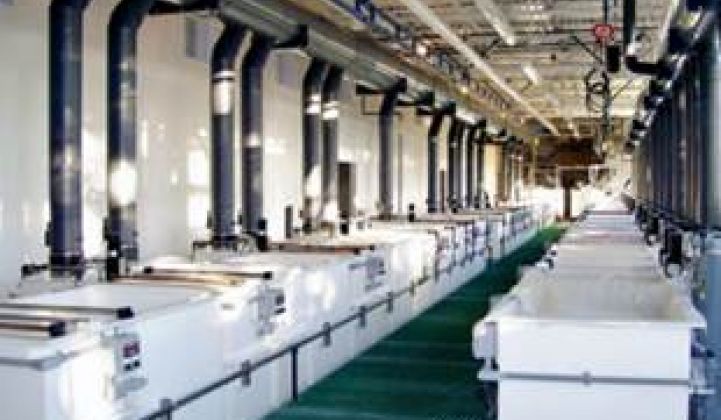A new design for the flow of electricity through solar cells that could cut module costs as much as 10 percent has been developed by GT Advanced Technologies.
GT’s Merlin metallization process replaces the three thick strips of silver that run through modules, called busbars, with thin lines of silver scattered through the cells. The silver lines, called fingers, function as the cell’s wiring, channeling electrons released when sunlight hits the cell’s semiconductor material into the electrical system.
GT said Merlin can be retrofitted into existing cell manufacturing lines’ screen printers. An additional attachment tool would insert a coated copper overlay with a tab at the cell's edge. Electrons flow through the Merlin architecture from the silver fingers into the copper overlay and to the tab.
"The concept seems to have potential, because it attacks some critical areas in the manufacturing process and module design,” said GTM Research Lead Upstream Solar Analyst Shyam Mehta.
The solar industry’s drive to reduce silver use is a topic that merited its own section in GTM Research’s recent report on crystalline silicon technology, authored by Mehta and Andrew M. Gabor. “The cost of the silver paste fingers and busbars on the front and back of standard solar cells represents the largest cost in the cell after the wafer," they wrote.
In the new design, rather than flowing through the three busbar channels, electrons pass through the twenty copper channels in the overlay through widened interconnections on the tabs that serve to streamline the flow.
Each cell would be 0.7 percent more efficient than standard designs because the narrower, thinner silver fingers expose slightly more of the cell’s surface to sunlight. In addition, the overlay reduces resistance and recaptures reflected incident light, according to GT Communications Director Jeff Nestel-Patt.
The 80 percent reduction in silver also makes the modules significantly lighter in weight, Nestel-Patt said. That would reduce shipping costs and make for easier handling and installation. He added that the tabs also make the module more flexible and durable, because the busbars’ three failure points are replaced by the tabs’ twenty interconnections.
With the increased flexibility, a finished module would not require an aluminum frame, furthering the weight reduction, Nestel-Patt said. But Merlin modules will fit any existing mounting system and be seamlessly attachable, through standard junction boxes, into any rooftop solar system architecture.
Cost reductions in the module -- through electrical and structural balance of systems, along with labor -- add up to an installed price reduction of 10 percent, according to GT.
“The International Technology Roadmap for PV predicts a steady reduction in silver usage with large-scale adoption of plated copper starting around 2015,” GTM Research reported.
Other firms are also exploring alternatives, Mehta said.
Both the SmartWire Connection from Meyer Burger (obtained when it acquired when it bought Day4 Energy), and Schmid’s solution, which eliminates rear silver and loosens alignment requirements during tabbing and stringing, would get to a similar silver reduction and cell efficiency increase, according to the GTM Research report.
JA Solar, Heraeus and Ferro are also working on concepts that would reduce the area and thickness of the silver busbars. Others are working to decrease silver use (despite the efficiency losses this would entail), increase the number of interconnect wires, and decrease finger sizes, or alternatively, to use copper plating or pastes.

“Conventional wisdom holds that copper front metallization will take significant market share from silver within a few years. In 2008, it was thought to be just a few years away. Likely, it will still be a few years away in 2014,” GTM Research reported.
“Everybody is trying to take silver out of the process because it is expensive. The challenge is finding a low-cost, high-volume process,” Nestel-Patt said. “We think we’ve found it, but we still have to prove it.”
GT’s Merlin pilot line is now operational. Certification and scale capability are expected during the second half of 2014, while commercial availability is planned for the first half of 2015. GT sees a market opportunity of between $400 billion and $1 billion by 2018.
Besides competition from alternative concepts, Mehta said, GT will likely encounter the typical initial resistance to the innovation. The accumulation of pilot data to support the company's claims will help alleviate this resistance.
“Module companies in general are pretty comfortable with tabbing and stringing at this point, and copper plating is not something most producers are familiar with,” Mehta said. But 2015 is “shaping up to be the year that manufacturers resume investing in new capital equipment…[and] Merlin could ride that capital spending wave.”
GT may face one other obstacle, according to Canaccord Genuity analyst Jonathan Dorsheimer. “The Merlin technology shows a lot of promise...[but the company's] ability to defend and protect this IP with a largely China-centric customer base has us somewhat hesitant.”
“We have been doing business in China since 2002,” Nestel-Patt said. “The way you protect IP there is to continue to innovate and stay ahead of the people who would steal your technology.”



